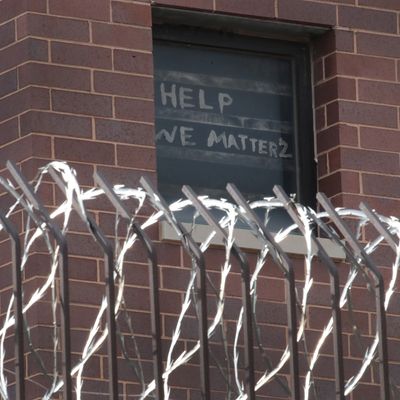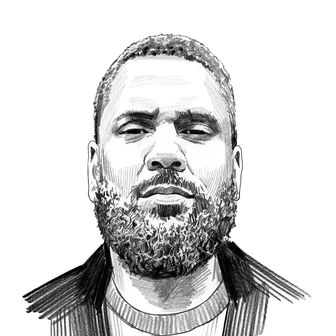
The Cook County Jail in southwest Chicago is America’s biggest known source of coronavirus infections. There are bigger metropolitan epicenters to be sure, like New York City; there are places where COVID-19 death rates are higher, like New Orleans and Detroit. But according to the New York Times, no other localized outbreak where analysts have been able to track how the virus was contracted and how it’s spreading outpaces Illinois’s largest jail. As of this writing, there were 401 cases in the facility, which houses 4,500 prisoners. That’s more than at the Life Care Center in Kirkland, Washington, the nursing home where two-thirds of the residents (129 in total) fell ill in February and March, and the 119 cases that transformed New Rochelle, New York, into a National Guard–patrolled containment zone — combined.
The jail’s devolution into a viral hotspot brings new urgency to questions about the efficacy of incarceration. A similar outbreak at Rikers Island in New York is leading some observers to a sobering realization: that for many detainees, prolonged stays in jail nowadays could be a death sentence. “You’re asking people to sit in death cages right now, [often] for something that isn’t against the law,” Cara Hoffman, a paralegal case handler for the Legal Aid Society of New York City, told me last month. One judge who Hoffman recently saw rule on whether to send a defendant to Rikers for a noncriminal parole violation was thwarted by his own conscience, and refused. “He kept saying, ‘I just can’t hold this guy right now.’”
This spirit of amnesty has been unusually widespread. In many places, officials are heeding the advice of medical experts and legal advocates and freeing detainees in large numbers to slow the virus’s spread. New York State has committed to releasing up to 1,600 people from its jails, including many in the city. Cook County Jail has freed “several hundred,” according to the Times. Even so, neither has managed to shrink their jail populations substantially, which remain several times larger than the share of prisoners released — that is to say, not nearly enough to stop these facilities from being serious vectors for infection. They’re still overcrowded, filthy, and short on cleaning supplies that are accessible to prisoners, not to mention too slow freeing anybody to effectively outpace the rising infection rates.
Much of this is attributable to officials deciding to only free those prisoners who bear the least political risk. “We have very little wiggle room,” Cook County Sheriff Thomas J. Dart told the Times, explaining that 86 percent of the prisoners who remain in his jail now are locked up for charges related to “violent crimes.” This is false; there’s plenty of wiggle room, just not much political will to push its boundaries. It’s well within the capacity of elected officials — sheriffs, prosecutors, the governor — to free everyone imprisoned today and keep the rest out; fear of being seen as “soft on crime” is a likely culprit for their decision not to. Less disputed, though, is the incongruity of forcing people to languish behind bars, waiting for a potentially deadly virus to pick them off, when their sole reason for being there is a nonviolent misdemeanor charge, noncriminal technical parole violation, or inability to afford bail. There’s a broadening consensus that these prisoners should be let go. What’s more, that so many are being freed with no consequent crime spikes or public safety crisis materializing is revealing: It suggests that the security rationale for imprisoning them in the first place was weak, if it existed at all.
But even assuming that freeing the rest, the “violent” ones, would cause crime to rise, or voting taxpayers to get hurt — both of which are impossible to accurately predict — this raises further questions about who deserves to be imprisoned during a pandemic at all. The term violent crime invoked by the sheriff here as a self-evident rationale for a condemning prisoners to a torturous death, encompasses a wide range of offenses — from mass murder, to shoving someone during the only robbery you’ve ever committed. The argument for keeping the former locked up would be, no doubt, more compelling for many people than the latter. But even that applies mainly to normal circumstances, when jails and prisons are mere habitats of sustained torture, not hothouses for deadly pathogens. Times are different now. To say that a person deserves either, today, means that they also deserve to get very sick, endure weeks of fever, cough so violently that they’re too exhausted to move, and eventually succumb to fatal respiratory distress, gasping for air under the helpless gaze of an overwhelmed doctor. Plenty of Americans are no doubt comfortable with condemning their convicted countrymen to such a fate. Those who are less sure, though, and even those who find the non-pandemic status quo to be broadly acceptable, have much to consider as the coronavirus charts its course.
That there are no easy answers is a given. But whatever one’s preferred solution to the prospect of prisoners who’ve committed acts of violence getting sick and dying of COVID-19, a system that requires anybody to be caged in tight and squalid quarters, unable to protect themselves from a pandemic, and spared in spurts only if they fit into some law enforcement-devised tier of worthiness, is begging to be upended. Americans’ collective zeal for punishment has produced a situation where the absolute worst single-site COVID-19 outbreak is in a county jail. That degree of exposure isn’t merely an occupational hazard of doing crime. It’s a symptom of a culture choosing, as its preferred solution to lawbreaking, to lock people away in some of the filthiest, most violent, least humane conditions imaginable, then turning a blind eye to their suffering.
Jails and prisons are bad on a good day. Whether anyone deserves to be confined there at all is a ripe topic for debate. But equally pressing now is that the narrow categorizations used to answer the same question — “violent” or “nonviolent,” misdemeanor charge versus felony — are even less adequate during a pandemic. People are dying avoidable deaths while officials dole out amnesty piecemeal. And it’s not just prisoners: In some places, the corrections officers tasked with guarding them are dying at even higher rates; on Rikers Island, one detainee has died, but so have seven jail employees. This is an acceptable tradeoff for many officials, justified under the auspices of keeping the rest of us safe. But we don’t have to agree. More humane alternatives are within reach. We just have to be bold enough to ask ourselves what they are, to pursue them, and to embolden those in charge to do the same.






























